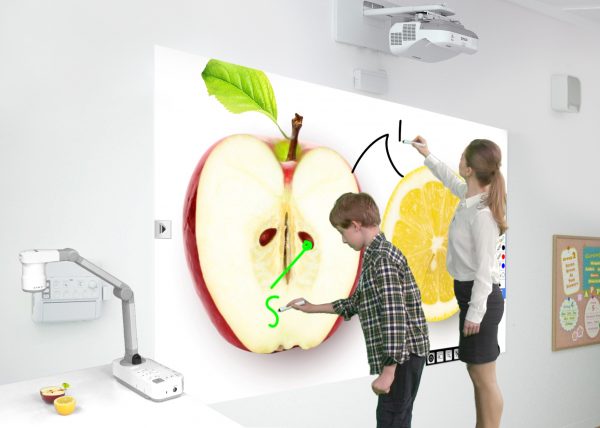It is no surprise that learning in the classroom is no longer limited to just textbooks and journals. Technology has made inroads into every aspect of our life including the way education is being imparted. AV technology in the classroom is now considered an important tool to help children understand better and quicker. In order to enable an interactive and enhanced learning experience, the majority of the schools these days are embracing classroom AV solutions.
This emphasis on visual and multimedia learning content has made the projector an essential element of modern classroom AV solutions. The large display generated by the projector ensures that every member of the class has visibility to the topics being discussed. When combined with engaging learning content, they help teachers hold and maintain student’s attention in classrooms, which in turn benefits the learning process.

But buying a new projector for your classroom can be a confusing experience since there is a wide variety of choices out there. Our simple projector buying guide will help understand the basics of terminology, features, and other important aspects to consider while making your choice.
Top 5 things to consider when choosing a projector for classroom use
1. How many lumens are ideally needed?
Projectors come in a range of brightness measured in lumens. The brighter the projector, the higher the lumen rating. Needless to say, higher lumens mean higher pricing. When buying a projector, ensure to look for two types of lumen specifications: lumens for color brightness and lumens for white brightness. The amount of brightness needed for your classroom is determined by the room’s ambient light condition. For classrooms, boardrooms and conference rooms with controlled lighting environments, opt for a projector with a minimum brightness of 2,500 lumens.
Recommendations from an expert: For brighter rooms with larger windows it may be better to select a projector with an image brightness rating of about 3500 lumens. Alternatively, shades or blinds could be installed to help control the room lighting.
2. What are the interactivity options offered?
These days, projectors can be much more than just devices that project images onto a projection screen. Leading projectors in the market sport smart, interactivity capabilities, such as touch gestures and interactive pens for annotations. This opens up exciting teaching and learning opportunities.
Interactive whiteboards are slowly being replaced with interactive projectors that require much less space to install. User scroll, press, tap, pinch in/out and rotate images using your fingers, that too without a PC. Both teachers and students can also annotate on the on-screen images with their fingers or interactive pens. This encourages student-and-teacher interaction on the same screen. Interactive projectors may also let you connect multiple PCs, tablets and smartphones over a wireless network to foster collaboration among users, who can simultaneously annotate on their individual devices.
Recommendations from an expert: Interactive projectors are a powerful tool in more collaborative learning environments. Check the level of multi-touch support in case several people need to participate simultaneously. Some projectors allow up to 6 point multi-touch support to enable this.
Also Read:- Looking at what Interactive Whiteboards have to offer
3. How much is the throw distance?
A projector’s throw distance is the distance between the projector and the image on the screen. Long-throw projectors are required for projecting large screens, while short throw projectors are ideal for smaller rooms such as a classroom and boardroom to reduce shadows and eye glare. Short-throw projection generally refers to a distance between 3-8 ft. away from the projector to the screen to project an 80” diagonal screen (roughly).
Ultra-short throw projectors are usually installed on the wall or the ceiling, completely eliminating shadows and eye glare. Ultra-short-throw projection refers to a distance between 0-4 ft. from the projector to the screen.
Recommendations from an expert: Ultra-short throw projectors help prevent disruption of the display due to obstruction of the projection when someone (teacher or student) is moving around the room. It also ensures that the projector is mounted safely out of the way.
4. Is the projector easy to use? Does it have multiple connectivity options?
Numerous projectors support multiple input sources. However, you should buy a projector that has input provisions for your media player or content sources.
Apart from supporting wireless projections via a computer or smart device, today’s interactive projectors also let connect high-definition sources such as Blu-ray players or Apple TV via HDMI ports.
Recommendations from an expert: Both students and teachers should find it easy to get the projector up and running. For hassle-free projection, you should look for projectors that feature quick setup for easy and quick projection.
5. What about its warranty and repair policy?
It is no surprise that sometimes technology fails ― either due to accidental misuse or sometimes without any possible reason. And, when something fails, having a warranty policy that is designed for schools is imperative in making sure classrooms are up and running as soon as possible.
Recommendations from an expert: Look for a brand that has a strong warranty and repair policy with a local service center. In cases where you are not able to interpret the vague language in a warranty, ask the manufacturer to clarify the language in writing or ask them for clarification on the statements you don’t understand.
Also Read:- Advanced smart classroom tools to enhance learning experiences
For more information on the latest interactive classroom, training, and distance learning solutions.
Contact Actis at 022-30808000 or at contact@actis.co.in.


